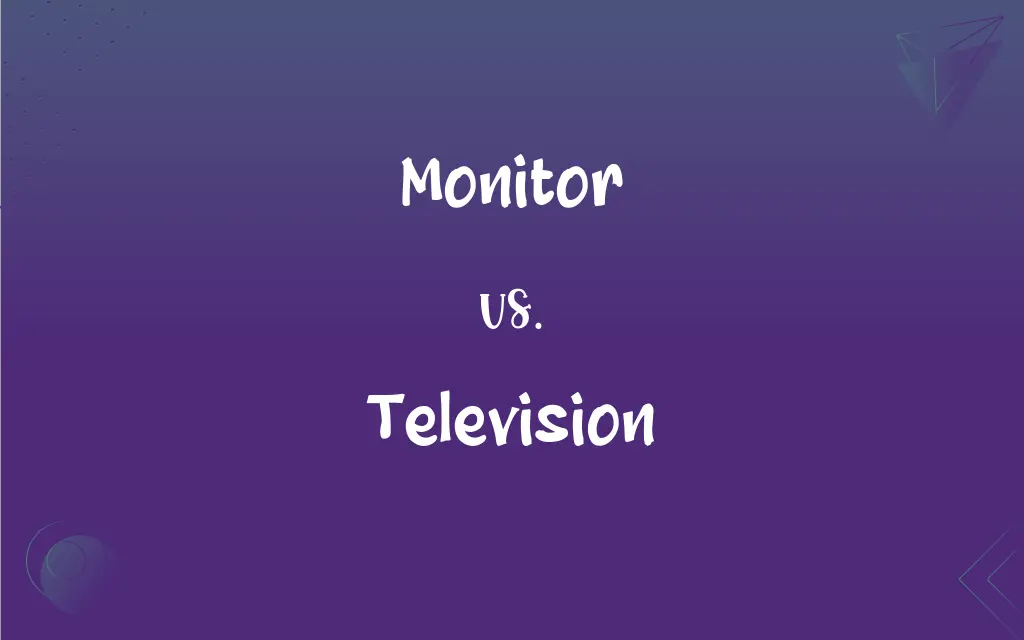Monitor vs. Television: What's the Difference?
Edited by Aimie Carlson || By Janet White || Published on February 9, 2024
A monitor is a display device primarily for computers, focusing on clarity and precision, while a television is designed for broadcasting media with integrated tuners and speakers.

Key Differences
Monitors are display devices optimized for computer interfaces, emphasizing resolution, refresh rates, and color accuracy for detailed and precise images. Televisions, however, are built primarily for watching broadcasted or streamed content, focusing on larger screen sizes and built-in audio capabilities.
The primary function of a monitor is to serve as a visual output for computers, often used in work and gaming environments where image clarity and minimal input lag are crucial. Televisions are designed for entertainment purposes, offering features like smart capabilities, streaming services, and various input options for external devices.
Monitors generally have higher pixel density and faster refresh rates, catering to the needs of graphic designers, gamers, and professional use. Televisions prioritize picture quality, dynamic range, and color depth for an immersive viewing experience, often with a wider viewing angle.
Connectivity options on monitors typically include HDMI, DisplayPort, and VGA, catering to computer and gaming console use. Televisions, on the other hand, offer a broader range of connectivity options, including HDMI, USB, and sometimes even built-in Wi-Fi for internet access.
Monitors are designed for close-up viewing, offering sharper and more consistent images at closer distances, while televisions are built for viewing from a distance, often in living rooms or larger spaces, with screens designed for comfortable viewing from several feet away.
ADVERTISEMENT
Comparison Chart
Primary Use
Computer interface display
Broadcasting media and entertainment
Image Quality Focus
Clarity, precision, refresh rate
Picture quality, dynamic range, viewing angle
Audio Capabilities
Typically without built-in speakers
Generally includes built-in speakers
Connectivity Options
HDMI, DisplayPort, VGA
HDMI, USB, Wi-Fi
Viewing Distance
Designed for close-up use
Optimized for viewing from a distance
ADVERTISEMENT
Monitor and Television Definitions
Monitor
A monitor connects to computers, laptops, or consoles.
She connected her laptop to an external monitor for a dual-screen setup.
Television
TVs are designed for a wide viewing angle and dynamic range.
The television provided a clear picture even from the side.
Monitor
Monitors emphasize high resolution and refresh rates.
The graphic designer chose a monitor with accurate color representation.
Television
Televisions often include smart features and built-in speakers.
The smart television allowed them to stream their favorite shows.
Monitor
Monitors are used for detailed and precise visual output.
The 4K monitor provided exceptional detail for video editing.
Television
Television sets usually have diverse connectivity options.
Their television was connected to a cable box, game console, and a streaming device.
Monitor
Monitors typically lack integrated tuners or speakers.
His monitor had no built-in speakers, so he used external ones.
Television
A television is a device for watching broadcast and streamed content.
They watched the news on their new flat-screen television.
Monitor
A monitor is a display screen for computers.
He bought a new monitor for his gaming setup.
Television
Televisions are optimized for viewing from a distance.
The large television was perfect for their spacious living room.
Monitor
One that admonishes, cautions, or reminds, especially with respect to matters of conduct.
Television
An electronic broadcast system in which special providers transmit a continuous program of video content to the public or subscribers by way of antenna, cable, or satellite dish, often on multiple channels
A new sitcom on television.
FAQs
Do monitors usually have speakers?
No, they typically require external speakers.
What is a monitor?
A display device mainly for computers.
Can a TV be used as a monitor?
Yes, but image clarity may vary.
Can a monitor be used as a TV?
Yes, with appropriate input sources.
Are monitors or TVs better for gaming?
Monitors, due to higher refresh rates and lower latency.
Do monitors have better resolution than TVs?
They often have higher pixel density.
Are TVs more expensive than monitors?
Depends on the model and features.
What is a television?
A device for viewing broadcast and streamed media.
What are smart TVs?
TVs with internet connectivity and apps.
What screen sizes do monitors have?
Usually smaller than TVs, up to 32 inches.
Can you stream on a monitor?
Yes, with a connected streaming device.
Can you use a TV for video conferencing?
Yes, if connected to a computer or camera.
Do televisions come with built-in tuners?
Yes, most include integrated tuners.
What connectivity options do monitors have?
HDMI, DisplayPort, and sometimes VGA.
Are monitors good for professional work?
Yes, especially for graphics and video editing.
Can monitors display TV channels?
Yes, with a connected TV tuner or streaming device.
Do TVs have wider viewing angles?
Generally, yes.
What makes a TV smart?
Built-in Wi-Fi and streaming capabilities.
Do TVs offer better sound quality?
Usually, due to built-in speakers.
Is a monitor or TV better for office work?
A monitor, for closer and clearer viewing.
About Author
Written by
Janet WhiteJanet White has been an esteemed writer and blogger for Difference Wiki. Holding a Master's degree in Science and Medical Journalism from the prestigious Boston University, she has consistently demonstrated her expertise and passion for her field. When she's not immersed in her work, Janet relishes her time exercising, delving into a good book, and cherishing moments with friends and family.
Edited by
Aimie CarlsonAimie Carlson, holding a master's degree in English literature, is a fervent English language enthusiast. She lends her writing talents to Difference Wiki, a prominent website that specializes in comparisons, offering readers insightful analyses that both captivate and inform.







































































